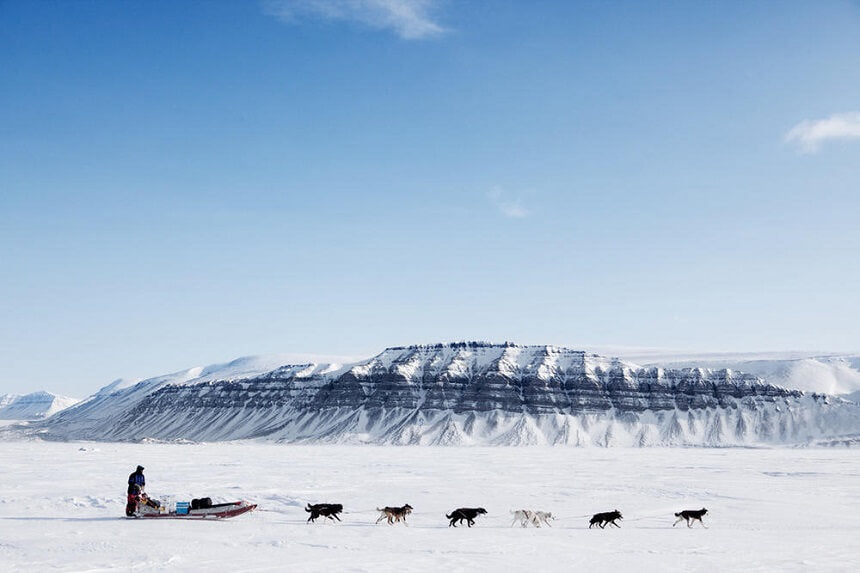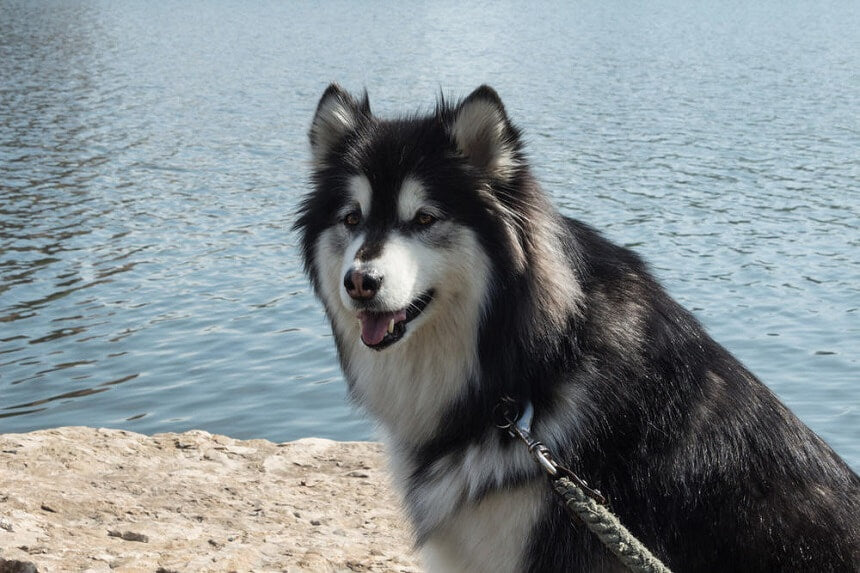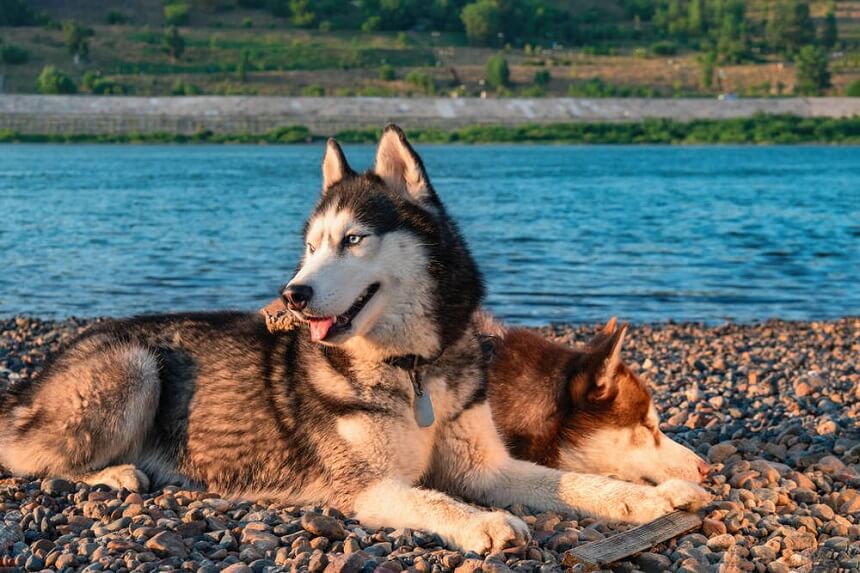What's the Difference Between an Alaskan Malamute and a Husky?
You must have seen a dog a Husky in your life, but you are not sure if it is really a Husky or not. If that dog was not a Husky, he must probably be Alaskan Malamute or his Siberian Husky cousin. There are three types of dogs with the same appearance as the wolf, but they all have a different heritage.
In this article, we will discuss the difference between the Alaskan Malamute and the Siberian Husky is. The temperament, history, lifespan, price, and other differences between the two breeds will also be discussed.

Alaskan Malamute vs. Siberian Husky Comparison
|
Traits |
Siberian Husky |
Alaskan Malamute |
|
Size |
20-22 inch tall |
20-25 inch tall |
|
Weight |
30-60lbs |
85-100lbs |
|
Color |
Black, Red, Grey, Sable and White |
Light grey, Black and Shades of Grey |
|
Coat |
Medium length, double coat |
Long length double coat |
|
Life span |
10-14 years |
10-12 years |
|
Intelligence |
Very intelligent |
Intelligent |
|
Temperament |
Friendly, playful and independent |
Playful, confident and friendly |
|
Socialization |
Pack animal friendly with other dogs |
Can be aggressive with some dogs |
|
Energy level |
Highly energetic need mental stimulation |
Less active but still need exercise |
|
Destructive behavior |
Jump fences and escape |
Digging and chewing |
Alaskan Malamute Breed Info
The Alaskan Malamute has a very eye-catching appearance, and they have a very sturdy and powerful body. They have deep roots in ancient history. They possess a lot of strength and stamina. They are so energetic that they need continuous supervision to avoid any challenge or accident.

Appearance
Alaskan Malamutes have a very stunning appearance. They have a curly tail at the back and pointed ears. Their alert and cheerful nature express a lot about their conserved energy. Their medium-sized muscle and almond-shaped eyes make them unique.
Their muscular body is covered in a double fur coat. The outer coat is rough and short, while the inner coat is dense and soft like wool. Their beautiful coat combination helps these dogs pull the sled in freezing temperatures. Their outer fur varies greatly in colors and has different colors such as black, brown, gray, sable, red, seal, and silver. The white Alaskan Malamute is the only member of this breed that has a solid-colored coat.
Size
The weight of the male and female Alaskan malamute is different. Males weigh 80 pounds and 25 inches tall. The weight of the females is around 75 pounds, and the average height is 23 inches. At some point, a well-muscled adult can weigh up to 100 pounds or even 140 pounds, but the Alaskan body is not designed for that much weight.
Temperament
Alaskan Malamutes can win your heart over with their playful and gentle nature. They are very friendly to all people, even strangers, so they are not good watchdogs. However, they love their family and will do anything for them.
Malamutes love to live in packs, and they like to be involved in all their family activities. They are not extreme barkers but are famous for a characteristic "woo woo" sound.
Their temperament depends on different factors such as training, heredity, and socialization. Malamutes puppies have such a pleasant nature that they love to be handled and approached by people. Due to his cute gestures, you may want to adopt a puppy in the middle of a road.
However, it is essential to learn about the dog's temperament before adoption to have no worries in the future. You must know the puppy's family and even look at his siblings to see the puppy's behavior.
Price
The price of an Alaskan malamute from a reputable breeder is between $ 1,500 and $ 2,000 per puppy. But the rescued and matured Malamute is relatively cheaper.
Life span
The lifespan of the Alaskan Malamute is around 11 years. So if you are adopting one, don't worry, you will get a life companion.
History
The Alaskan Malamute is descended from Arctic wolves. They get their name from an Alaskan tribe called Mahlemuts, famous for raising and caring for these dogs. Their history dates back to 2000-3000 years ago, where they were used by the Mahlemuit Eskimos of Alaska in their regular transportation.
Due to their strength and disposition for work, these dogs travel on sleds and transport different food and other supplies for the people in their area. The entire herd of malamutes has a history of engaging in various polar activities. They are well adapted due to their sense of direction, tenacity, and great sense of smell.
You can also find their name in the stories of Rudyard Kipling and Jack London. A Malamute also went with Admiral Byrd for the expedition to the South Pole. Alaskan Malamutes are considered cousins to the American Huskies and the Siberian Husky. The basic talent of almost all malamutes is carting, sledding, traction, and racing.
Siberian Husky Breed Info
No one can resist falling in love with these beautiful Huskies, and that's without knowing anything about this breed and its characteristics. Huskies are not for everyone; however, their beauty appeals to everyone, but Siberian Huskies often end up in shelters due to their complex traits.

Appearance
Their blue eyes are their primary source of attraction, and some even b-eyes, a term used for dogs with one brown eye and the other blue. Another type of eye that Siberian Huskies have is pati-eyes, where there are two different colors in the same eye. For example, one quarter is brown, and the remaining three quarters are from other colors. This trait of the huskies is unique, memorable, and different from the others.
Siberian Huskies are available in different colors with different markings on the body and head. They can be any color between pure black and pure white.
Huskies are "double-haired" dogs with top and bottom coats. The topcoat contains smooth hairs, while the undercoat has fluffy hairs that are usually white, but in some cases, pale beige.
Their coat is designed in such a way that it remains warm in winter and cool in summer. Their fur can withstand sweltering weather, which is why you have never seen a Siberian husky with their fur shaved, no matter where they are, and even the temperatures rise higher. They love to swim, and when the opportunity arises, they will not waste time and immerse themselves in cool water.
Size
An average male Siberian Husky stands between 21 and 23.5 inches tall, and females are between 20 and 22 inches. The adult male weighs between 40 and 60 pounds and the females between 0 and 50 pounds.
Temperament
Siberian Huskies are classic sled dogs. They are famous for their stubborn and independent nature. They love living in the human company but need regular training from the start. However, this breed loves to run and will often run long distances even when their owner is around. Huskies are very friendly with children and other people.
If you raised a Husky from a young age with other animals, they would be very good with them. However, due to their excellent prey drive, you will often find them running after cats and livestock. Huskies love to stay in cool places in the summer, so you will often find them digging to find a cool place. Like their cousin, they don't bark but howl.
Price
The price of the Siberian husky ranges from $ 400 to $ 1000, depending on its breeder.
Life Span
On average, Huskies can live up to 12 years.
History
Huskies originate in a nomadic Siberian tribe called the Chukchi. The breed history is unclear, but it is clear that he is one of the oldest living dogs on the planet. At first, the Chukchi tribe used this dog for quick transportation, and they behaved like family dogs to them. Huskies love to play with children.
They were imported to Alaska in 1908 during the Gold Rush era. They were also used in the dog race, a 408-mile dogsled race, and are active members of this race even today.
According to records, the last Siberian Husky was imported in the 1930s before the closure of the border by the Soviet government. This breed became a common resident of North America, where they changed somewhat from their Siberian ancestors or Chukchi ancestors. Huskies were recognized by the Canadian Kennel Club in 1939 and the American Kennel Club in the 1930s. In 1938 the Siberian Club of America was founded.
Frequently Asked Questions About Malamutes And Huskies
1. What is the Difference Between the Temperament of Huskies and Malamutes?
They almost have a similar temperament with some differences. Malamutes love human affection, and huskies love spending time independently.
2. Are Malamute and Huskies Vocal?
Both Huskies and Malamutes have the same energy levels and are not very vocal but tend to howl.
3. Are Malamutes More Aggressive Than Huskies?
Malamutes and huskies have the same temperament, they are very friendly with all people, but malamutes, nevertheless, sometimes become aggressive towards other animals.
4. Which Breed is Better for You?
Huskies and Malamute love their owner, and the choice of the dog is entirely up to you. If you can satisfy their need for exercise and run, either breed is ideal for you.
Final Thoughts
Now you must have understood the differences between Huskies and Malamute. Both breeds have their unique personality and traits, but one thing for sure is that you need to take care of them and take the time to train and exercise them.
Don’t forget to leave your questions below the comments at the end of the article. If you found this article useful and interesting, please don’t forget to share it with your friends and family.
READ NEXT:


Leave a comment